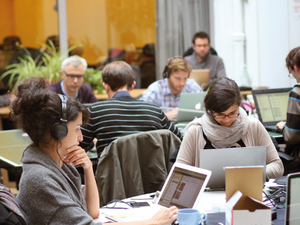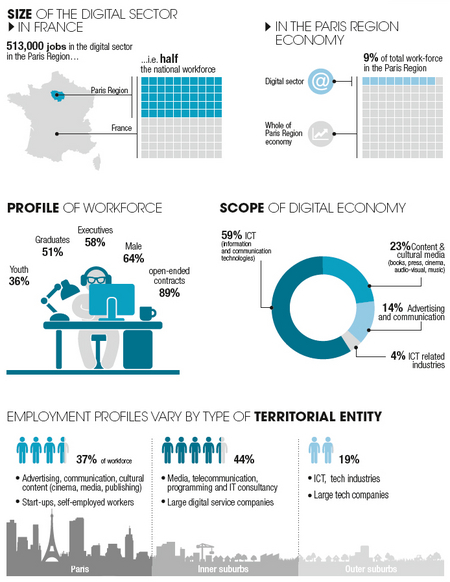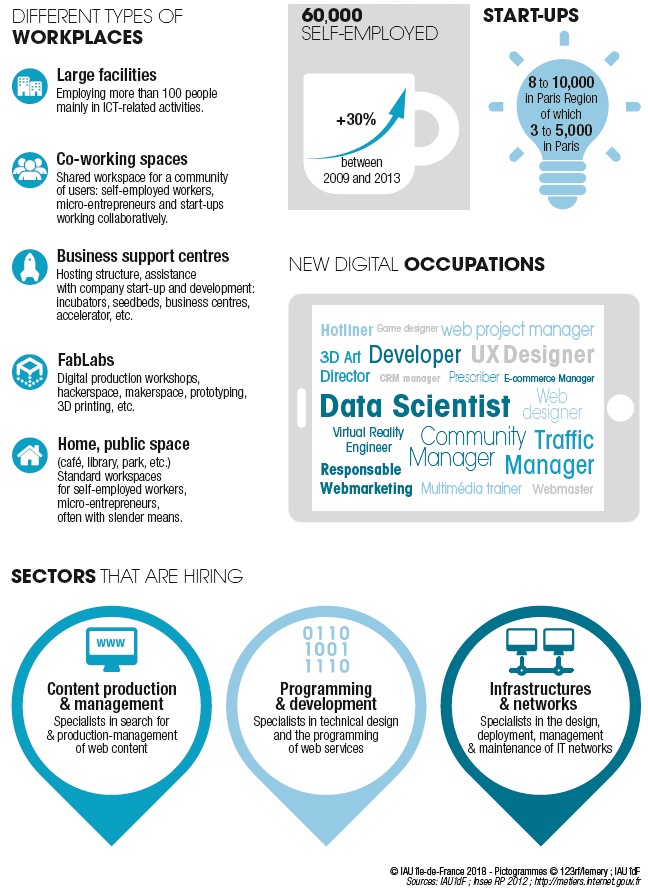Offices under digital influence
It is now possible to work anytime, anywhere and in networking mode. This revolution, driven by connected mobility and collaborative economic development, is conducive to the opening of new work places, i.e. third places suitable for collaboration, temporary occupation and the sharing of resources. At the same time, traditional offices are adapting to new uses, their watchword being ‘flexibility’.
Digital tools continue to be used more and more in work practices. Today, more than half of salaried employees (56%) have access to their professional messaging when they are not at their places of work. Beyond simple messaging, 17% of them have access to their company’s servers and intranet, a trend which is accelerating because of cloud computing. The use of mobile telephones for professional purposes continues to develop (45% of salaried employees in 2013), while working at home on a computer is four times more frequent than 15 years ago (24% of salaried employees). Unsurprisingly, this use of nomadic tools concerns executives more than workers or clerical staff.
Digital technology is expanding the frontiers of mobility…
Digital technology is expanding the frontiers of mobility by allowing people to work anywhere, at any time, and to collaborate with people who are sometimes very far away. Working ‘outside the walls’ when on the move, in third places or at home has become more frequent. In 2012, The French Ministry of the Economy estimated that the proportion of French employees in large companies practicing teleworking for over eight hours a month represented 12% of the workforce. According to J. Damon, 17% of the working population practice teleworking from home or nomadically. Although teleworking remains under-developed, the popularization of digital practices provides favorable conditions for the take-off of teleworking, which would reduce home-to-work travel, salaried workers’ fatigue and pollution, and would enhance the attractiveness of certain geographical areas. Recently, the French General Commissariat for Territorial Equality issued proposals for a National Teleworking Plan. The Paris Region seems to provide fertile ground for teleworking: saturated means of transport and great pressure on land are encouraging the development of connected mobility in all its forms (from teleworking to coworking). This is partly due to the fact that executives, who use digital tools more than other people, are more numerous in the Paris Region than elsewhere in France. The practice of teleworking illustrates this trend well. In answer to the question: “Do you sometimes work at home instead of at you workplace, with your employer’s consent?”, 11% of economically active inhabitants of the Paris Region answer: “yes, regularly or occasionally”, compared with 7% of people in the provinces. The gap is particularly wide regarding occasional teleworking, and is almost exclusively due to Parisian workers, who represent a very large proportion of teleworkers.
Nomadisation “within the walls” of a company generates increased needs for shared collaborative spaces
… And encouraging the creation of new work places
Thanks to digital technologies, shared places that provide flexibility, such as coworking spaces, FabLabs, Repair Cafés, telecentres, etc. have been developing fast. They are used by self-employed people, entrepreneurs, very small businesses and mobile employees. The number of third places in the Paris Region is estimated at around 600, according to L'Institut Paris Region. In Paris and its inner suburbs, coworking spaces have considerably multiplied in recent years. The outer suburbs, in which 43% of the Paris Region’s economically active population (aged 15-64) live and work, have not followed this trend, even though they are home to numerous employees who work in the center of the agglomeration, and despite the efforts made for several years to develop new work places in these suburbs. The needs for third places are far from being met: thus, 30% of self-employed workers do not work in a third place ‘because there aren’t any near their home’. Today, the aim is to cover the whole region and notably the areas that are underequipped, but to do so by considering location criteria that will ensure a high number of users. Many projects in the Paris Region are based on this principle and are initiated by both private- and public-sector stakeholders.
- Through the Initiatives Télécentres 77 project, Seine-et-Marne county pioneered the networking of telecentres and coworking spaces. Established in 2012, this association aims to provide a joint offering of workplaces situated halfway between workers’ homes and their workplaces. It also provides office property solutions for self-employed workers and entrepreneurs.
- Around 50 workspaces were set up between 2013 and 2015 with the support of the regional council. In 2016, the Paris Region financed 41 third places, particularly in the outer suburbs. The goal is to establish 1,000 third places in the Paris Region by 2021, giving priority to doubling the number of third places in rural areas from 2016.
- French railways (SNCF) has set up teleworking spaces in several stations in the Paris Region. Its affiliate, Île-de-France Mobilités created 70 micro-working places in 2017 and 80 more are planned for 2018. The “Work and Station concept began to be deployed in 2016.
- Specialized private stakeholders have emerged, such as WeWork®, which opened a 12,000 sq. m. coworking space in 2017 in the Paris Central Business District (CBD) as well as a 7,000 sq. m. space in the Marais District. Long-standing office development operators have launched new third place concepts, such as Nexity’s “Blue Office” development and Bouygues Immobilier’s “Nextdoor” development.
Who are the players in the digital economy?
The office is dead, long live the office!
The rise of third spaces and of nomadism does not signal the end of the traditional office as a collective workspace for use by a company. Businesses will continue to be defined in spatial terms by providing a workspace that projects a sense of belonging. Even the digital giants are having dedicated campuses built. Thus, since May 2017, Apple Park in California has been home to 12,000 employees. In the Paris Region, digital stakeholders have massively invested in the Central Business District in which only banks and insurance companies used to be located. More generally, demand for offices in the Paris Region remains high, as indicated by the constant increase in the volume of property leased over the last five years. Decision- making, innovation and management processing will always require physical spaces, as these foster exchanges between salaried employees and ensure a certain degree of confidentiality. Nevertheless, by changing working methods, the digital transformation process is helping to reshape office buildings and to rethink the lay-out of office spaces. This adaptation process is not new. To meet the needs of changing economic, financial, technical and social conditions, the office space sector has had to make many adaptations, including: the out-posting of production functions from headquarters to production plants; the separation of back office functions from decision-making centers; and the introduction of modular and then open space offices. The most immediate impacts, which are already under way, are of a technical nature. The development of cloud computing means that office buildings must be connected to fiber-optic networks. Constraints on computer rooms have been diminishing. The spread of sensors and other connected objects makes it possible to watch over buildings in real time. These are becoming smart buildings whose operating expenses are finely adjusted to needs, with savings on expenses as a bonus. The new working methods enable businesses to optimize the potential of office buildings. Nomadization of work “within the walls” of a company has led to a greater need for shared collaborative spaces. These spaces may be hybrid, i.e. open to people from outside the company, or they may host business incubators related to the company’s activity. Thus, the new campus (called Les Dunes) of Société Générale bank in Fontenay-sous-Bois near Paris includes 1,000 sq. m. of space for hosting internal and external startups. The distribution of businesses within the space changes without affecting the overall surface area available.
Pascale Leroi and Renaud Roger, economists, IAU îdF
Further reading
This page is linked to the following category :
Economy



